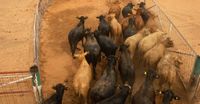It’s been a turbulent summer for cattle ranchers on both sides of the U.S.–Mexico border, and the culprit is no stranger to the livestock world: the New World screwworm, a flesh-eating parasite whose resurgence is now sending shockwaves through the beef industry, consumer markets, and government agencies alike. With meat prices climbing and livestock quarantines in full effect, the battle to contain this old foe has become a high-stakes race against time, innovation, and biology itself.
On August 6, 2025, U.S. Agriculture Secretary Brooke Rollins took decisive action, ordering an immediate shutdown of live cattle, bison, and horse trade through the southern U.S.–Mexico border. The trigger? A confirmed case of New World screwworm in Veracruz, Mexico. According to Border Report, Rollins stated, “I have ordered an immediate shutdown of live cattle, bison, and horse trade through the southern U.S.–Mexico border. This decisive action comes after Mexico confirmed another case of New World Screwworm in Veracruz.” She emphasized the U.S. Agriculture Department’s vigilance in protecting America’s livestock and food supply, signaling that the pause on livestock imports would remain until Mexico demonstrated further progress in eradicating the pest.
The screwworm’s return is not just a bureaucratic headache—it’s an economic and emotional blow for ranchers. Jesús Brígido Coronel, president of Mexico’s Beef Producers Association, told Border Report that the restrictions have cost the Mexican cattle industry between $25 million and $30 million every month. “For the industry that exports meat, there have been losses that can’t be made up by selling the beef here,” he said. The effects are already being felt in American supermarkets, where the price of meat has jumped by 20 percent due to the reduced flow of Mexican cattle. Coronel warned that prices are likely to keep climbing, making meat more expensive for U.S. consumers in the coming weeks.
All members of Mexico’s Beef Producers Association are following strict rules to prevent the screwworm from spreading north, focusing on eradicating the parasite within Mexico’s borders. But the U.S. government isn’t taking any chances. The import ban, which was briefly lifted earlier this year, was reinstated after the pest’s continued spread and a new case in Veracruz. Agriculture Secretary Rollins made it clear: “We are pausing the planned port reopening to further quarantine and target this deadly pest in Mexico. We must see additional progress […] in order to reopen livestock ports along the Southwest border.”
For those unfamiliar with the screwworm, its reputation is well-earned. As The New York Times reports, the larvae of the screwworm fly attack healthy tissue, burrowing into wounds and causing large, often fatal infections. Unlike other maggots that feed on dead matter, screwworms target living flesh, making them especially destructive. Ranchers like Judy McCullough of Wyoming recall the horror vividly: “Nothing’s nastier than this maggot,” she said, describing the blood, the smell of burning tar, and the constant fear of infestation when she was a child on her grandfather’s ranch.
The U.S. has a long history with the screwworm. In the 1970s, a massive eradication campaign pushed the parasite out of the country, saving the cattle industry an estimated $2.3 billion annually. The key was innovative science: government scientists pioneered a sterile insect technique, breeding and sterilizing millions of flies with radiation before releasing them into the wild. Because female screwworm flies mate only once, their union with sterile males produces no offspring, causing the population to crash over time.
For decades, a biological barrier at Panama’s Darién Gap kept the screwworm at bay. But in 2022, the parasite breached the barrier, spreading throughout Central America and southern Mexico. Since November 2024 alone, more than 2,700 cases have been reported in cattle in southern Mexico. The challenge of containing the outbreak is daunting. According to The New York Times, APHIS (the USDA’s Animal and Plant Health Inspection Service) estimates that “several years of intensive efforts” will be required to eradicate the current outbreak.
The U.S. and Mexico are now pouring resources into biological countermeasures. In 2023 and 2024, the USDA dedicated over $270 million to ramp up sterile fly production in Panama from 20 million to 100 million flies per week, establish animal checkpoints, and boost awareness in Central America. By the end of 2025, a new sterile fly production facility in southern Mexico is expected to produce between 60 million and 100 million flies weekly. Yet, that’s still short of the 500 million flies needed to re-establish the Darién Gap barrier. Another $30 million is being funneled into reopening a sterile fly facility in southern Mexico and a dispersal center in Texas.
But sterile flies aren’t the only weapon in the arsenal. Texas, facing the threat head-on, plans to deploy synthetic bait made of insecticide and “swormlure”—a chemical concoction mimicking the smell of open wounds—across every county along the Rio Grande. Sid Miller, the state’s agriculture commissioner, claims the bait is 90 percent effective in killing screwworms. The state is also exploring a screwworm vaccine and the use of ivermectin, a deworming medication, to treat infected animals.
Meanwhile, scientists are exploring cutting-edge solutions. In Mexico, researchers are investigating gene editing and evolutionary changes among screwworm flies in different regions. Uruguay’s National Institute of Agricultural Research and Institut Pasteur of Montevideo are experimenting with genome editing to create male screwworms that pass on infertility genes, potentially causing a sharp population decline over generations. Moisés Vargas-Terán, who led eradication efforts in Libya in the 1990s, cautions that most of these techniques are still experimental: “The only viable technique right now is the sterile insect technique.”
The threat isn’t limited to cattle. The screwworm’s appetite extends to other farmed animals, wildlife like deer and rabbits, pets, and even humans. Mexico recently reported its first human case. Miguel Galarde, a researcher at Mexico’s National Institute of Forestry, Agriculture and Livestock Research, warns, “The situation is critical.” He stresses that treating all wounds, regardless of future larvae, is essential to control the spread.
Efforts to contain the screwworm are complicated by workforce reductions. Earlier in 2025, more than 1,300 workers in APHIS took buyouts, including 300 in veterinary services. While APHIS says it has exempted critical positions and grown the screwworm team, experts like Dr. Kevin Shea, a former APHIS administrator, note that experience is as crucial as numbers: “Screwworm’s a pretty specialized thing, right? Not too many people know about it or ever worked in it, and if you lose people who have that expertise, that’s a big problem.”
As the crisis drags on, frustration is mounting in Mexico. President Claudia Sheinbaum called the U.S. decision to pause livestock imports “totally exaggerated.” Yet with the parasite’s northward march and the memory of past devastation still fresh, few on the U.S. side are willing to take risks.
For ranchers like Judy McCullough, the stakes are personal—and biblical. “Have you read the Bible? Revelation talks about a fly that does what these guys can do. So I’m just saying I hope we can keep it out,” she said. “I hope we can. Better say your prayers, man.”
As governments, scientists, and ranchers scramble for solutions, the screwworm’s return is a sobering reminder of how quickly nature can upend even the most carefully managed systems—and how much vigilance is required to keep a century-old threat at bay.




